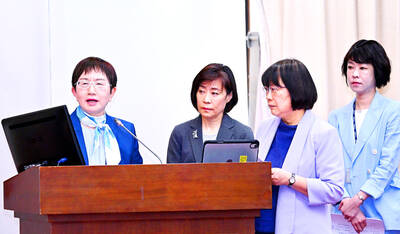Integrated Digital Technologies Inc (劍揚光學) said yesterday that it will start mass production of embedded solar cells in liquid-crystal-display (LCD) panels by the end of this year because of the increased popularity of panels known as interactive screens (iScreen).
The company said it would ship 5 million units of iScreen panels by next year, grabbing a global market share of 20 percent, Naejye Hwang (黃乃傑), Integrated Digital’s display division director, told a press conference.
“Unlike other touch screen panels that have extra film or glass with photo sensors on top of the regular LCD panel, Integrated Digital embeds solar cells in the thin-film-transistor [TFT] array layer during the panel-making process, thereby reducing the weight and thickness of the final product,” Hwang said.
This can save up to 30 percent of manufacturing costs because it reduces the need for additional film or glass components as well as additional labor, company founder and chief executive officer Hwang Huey-liang (黃惠良) said.
The company said the iScreen could be used on PCs, while its applications ranged from gaming, interactive Excel, Picasa, Google Earth as well as AtutoCAD and other drawing software. It said iScreens use less power and have an extended lifetime and unique remote control and writing capabilities.
The company will display its technology at Computex Taipei, which opens on Tuesday and closes on June 6 at Taipei World Trade Center Exhibition Hall I.
Meanwhile, VMAX Telecom Co (威邁思電信) will provide high-speed wireless Internet service on the MRT Muzha Line as part of its program for Computex Taipei.
It said WiMAX would be the main theme of this year’s show, using the slogan: “WiMAX on the Move.”
“There will be a more diverse display of [WiMAX] products and many are equipped with built-in WiMAX chips,” said Enoch Du (杜全昌), secretary-general of the Taipei Computer Association (TCA, 台北市電腦公會).
“This year, the entire [WiMAX] industry is expected to reach a growth rate of 50 percent and the output value will exceed NT$10 billion by the end of this year,” Du said.
Michael Chen (陳武宏), director of Intel Asia-Pacific Embedded Sales Group, said WiMAX has proved to be an economic and efficient broadband network.
Intel projected that the number of WiMAX subscribers worldwide could nearly double to 800 million by the end of next year, from 430 million at present, Chen said.
On April 27, Tatung InfoComm Co (大同電信) became the first company in Taiwan to launch its WiMAX service in Penghu.
Five more WiMAX operators are expected to launch commercial services in the second half of this year, Du said.

‘SWASTICAR’: Tesla CEO Elon Musk’s close association with Donald Trump has prompted opponents to brand him a ‘Nazi’ and resulted in a dramatic drop in sales Demonstrators descended on Tesla Inc dealerships across the US, and in Europe and Canada on Saturday to protest company chief Elon Musk, who has amassed extraordinary power as a top adviser to US President Donald Trump. Waving signs with messages such as “Musk is stealing our money” and “Reclaim our country,” the protests largely took place peacefully following fiery episodes of vandalism on Tesla vehicles, dealerships and other facilities in recent weeks that US officials have denounced as terrorism. Hundreds rallied on Saturday outside the Tesla dealership in Manhattan. Some blasted Musk, the world’s richest man, while others demanded the shuttering of his

ADVERSARIES: The new list includes 11 entities in China and one in Taiwan, which is a local branch of Chinese cloud computing firm Inspur Group The US added dozens of entities to a trade blacklist on Tuesday, the US Department of Commerce said, in part to disrupt Beijing’s artificial intelligence (AI) and advanced computing capabilities. The action affects 80 entities from countries including China, the United Arab Emirates and Iran, with the commerce department citing their “activities contrary to US national security and foreign policy.” Those added to the “entity list” are restricted from obtaining US items and technologies without government authorization. “We will not allow adversaries to exploit American technology to bolster their own militaries and threaten American lives,” US Secretary of Commerce Howard Lutnick said. The entities

Minister of Finance Chuang Tsui-yun (莊翠雲) yesterday told lawmakers that she “would not speculate,” but a “response plan” has been prepared in case Taiwan is targeted by US President Donald Trump’s reciprocal tariffs, which are to be announced on Wednesday next week. The Trump administration, including US Secretary of the Treasury Scott Bessent, has said that much of the proposed reciprocal tariffs would focus on the 15 countries that have the highest trade surpluses with the US. Bessent has referred to those countries as the “dirty 15,” but has not named them. Last year, Taiwan’s US$73.9 billion trade surplus with the US

Prices of gasoline and diesel products at domestic gas stations are to fall NT$0.2 and NT$0.1 per liter respectively this week, even though international crude oil prices rose last week, CPC Corp, Taiwan (台灣中油) and Formosa Petrochemical Corp (台塑石化) said yesterday. International crude oil prices continued rising last week, as the US Energy Information Administration reported a larger-than-expected drop in US commercial crude oil inventories, CPC said in a statement. Based on the company’s floating oil price formula, the cost of crude oil rose 2.38 percent last week from a week earlier, it said. News that US President Donald Trump plans a “secondary